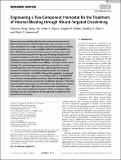Engineering a Two‐Component Hemostat for the Treatment of Internal Bleeding through Wound‐Targeted Crosslinking
Author(s)
Hong, Celestine; He, Yanpu; Bowen, Porter A; Belcher, Angela M; Olsen, Bradley D; Hammond, Paula T; ... Show more Show less
DownloadPublished version (4.483Mb)
Publisher with Creative Commons License
Publisher with Creative Commons License
Creative Commons Attribution
Terms of use
Metadata
Show full item recordAbstract
Primary hemostasis (platelet plug formation) and secondary hemostasis (fibrin clot formation) are intertwined processes that occur upon vascular injury. Researchers have sought to target wounds by leveraging cues specific to these processes, such as using peptides that bind activated platelets or fibrin. While these materials have shown success in various injury models, they are commonly designed for the purpose of treating solely primary or secondary hemostasis. In this work, a two‐component system consisting of a targeting component (azide/GRGDS PEG‐PLGA nanoparticles) and a crosslinking component (multifunctional DBCO) is developed to treat internal bleeding. The system leverages increased injury accumulation to achieve crosslinking above a critical concentration, addressing both primary and secondary hemostasis by amplifying platelet recruitment and mitigating plasminolysis for greater clot stability. Nanoparticle aggregation is measured to validate concentration‐dependent crosslinking, while a 1:3 azide/GRGDS ratio is found to increase platelet recruitment, decrease clot degradation in hemodiluted environments, and decrease complement activation. Finally, this approach significantly increases survival relative to the particle‐only control in a liver resection model. In light of prior successes with the particle‐only system, these results emphasize the potential of this technology in aiding hemostasis and the importance of a holistic approach in engineering new treatments for hemorrhage.
Date issued
2023-04-05Journal
Advanced Healthcare Materials
Publisher
Wiley
Citation
Hong, Celestine, He, Yanpu, Bowen, Porter A, Belcher, Angela M, Olsen, Bradley D et al. 2023. "Engineering a Two‐Component Hemostat for the Treatment of Internal Bleeding through Wound‐Targeted Crosslinking." Advanced Healthcare Materials, 12 (20).
Version: Final published version